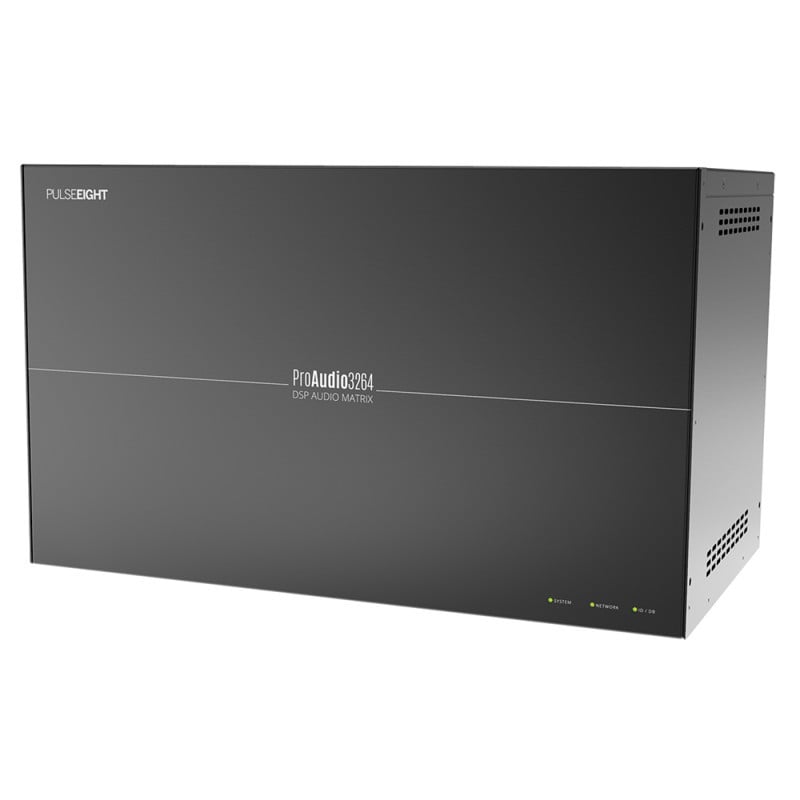





Not available.
delivery is not available for this product.
Livraison gratuite pour toute commande égale ou supérieure à 199 € sont limités à la livraison au sein de l'Europe
34,50 €
4 583,00 €
227,00 €
1 648,50 €
1 861,00 €
Détails du produit
Le ProAudio3264 DSP Pre-Amp Audio Matrix dispose de 80 entrées audio, 48 sorties analogiques et 64 sorties numériques, permettant une distribution audio simultanée vers plusieurs zones. Chaque zone de sortie peut être améliorée grâce à des fonctions intégrées, notamment un égaliseur à 5 bandes sur chaque zone, des réglages de volume et de gain, un contrôle du caisson de basses, un contrôle série et TCP/IP, un délai de synchronisation labiale et bien plus encore.
Technical characteristics
Pulse-Eight’s ProAudio range of DSP preamp audio matrices offers innovative features and unmatched capabilities within the range. Designed exclusively by our own engineering team, the ProAudio systems are a versatile and cost-effective multi-zone audio system.5 band graphic eqalizer on each zone
The ProAudio series provides maximum sound control including bass, treble and a 5 band graphic equalizer available for each zone. Audio and tone control is adjustable in 0.5 dB steps, and all allow direct or relative adjustments (Ex: set the volume to an absolute -12.5 dB, or increase it by 3.0 dB). The tone controls have a range of ±20 dB.
Adjustable gain settings on each input
To balance the different levels of audio coming from different pieces of equipment, each audio input has a full range gain adjustment. The adjustment range is: +24 dB to -99.5 dB, or full mute, in 0.5 dB increments.
Subwoofer control
With low pass and high pass filter settings adjustable from 50 to 300 Hz, selectable 12 dB/24 dB/oct slope with Butterworth or Linkwitz-Riley filters and selectable polarity for each zone, the ProAudio provides easily adaptable subwoofer control.
Doorbell / paging features
The doorbell connections on the reverse of the system provides the ability to connect doorbell / pager inputs to any output zone and to automatically lower the current volume and push through the doorbell / pager signal. This can also be adapted for fire/evacuation messages.
Volume and tone controls work on the digital inputs and outputs
For the extreme in ultra-quiet audio and lowest possible distortion, by mirroring the analog outputs to the digital outputs, you can input and output digital audio, completely bypassing the analog sections. No extra conversions are required and you still have volume, balance, bass, treble and 5 band equalizer controls.
Automatic audio conversion
It makes no difference whether your audio comes in through the analog inputs, digital coax inputs or digital optical inputs, all inputs can be converted to analog to provide full flexibility.
Note: The ProAudio does not down convert DTS or 5.1 Dolby audio. When DTS or 5.1 Dolby audio is detected, it is passed straight through from the digital coax input to the digital coax outputs. Analog inputs cannot be directly converted to digital outputs. To convert analog to digital, a digital output can mirror an analog output.
Keep it simple serial
Available through the TCP/IP port or the RS-232 port, our K.I.S.S.™ is one of the easiest to use, serial port protocols, on the market. Yet the extensive bi-directional command set allows total control over the ProAudio.
Front panel with removable rack ears
How frustrating is it when your product arrives from a manufacturer with no rack ears? All Pulse-Eight’s professional systems ship with the rack ears integrated into the product or with removable ears. Unpack and install directly into the rack.
Lip sync delay
When moving audio around, lip sync can often be an issue. Within each ProAudio system, we provide up to 170 ms of lip sync delay so that your audio/video matchup doesn’t look like a 1950’s Godzilla movie.
Zone locking
Lock as many output zones as you wish to create a group of outputs that all automatically switch simultaneously to the same input source.
Stereo to mono downmix for each zone
For hallways, and outdoor speakers, where stereo is not particularly useful, each zone can be mixed from stereo to mono using a variety of different methods.